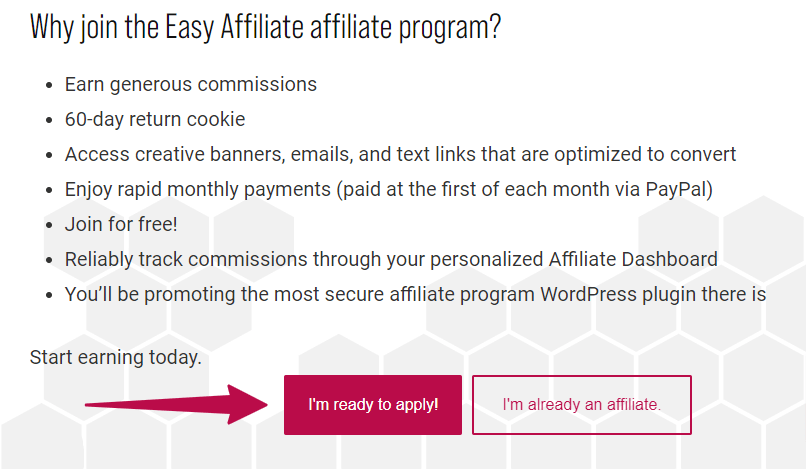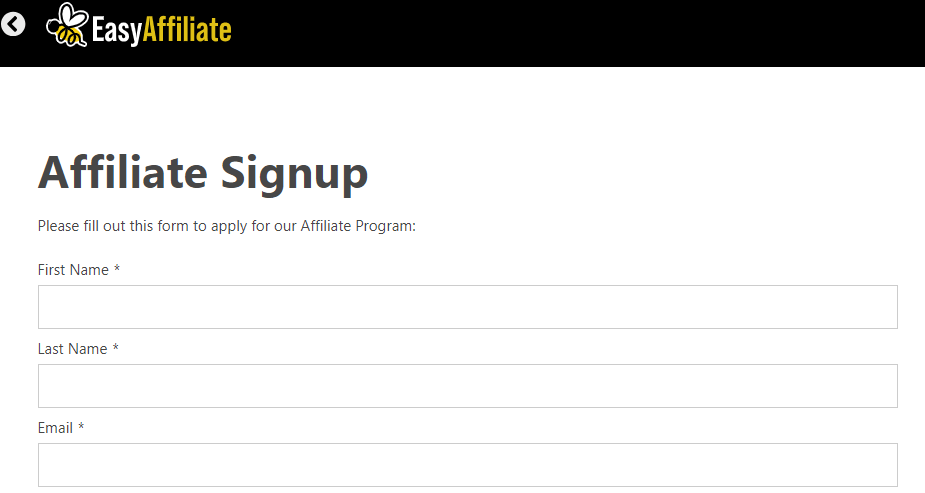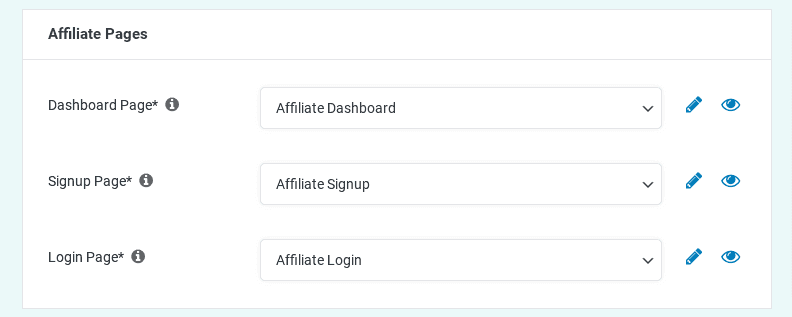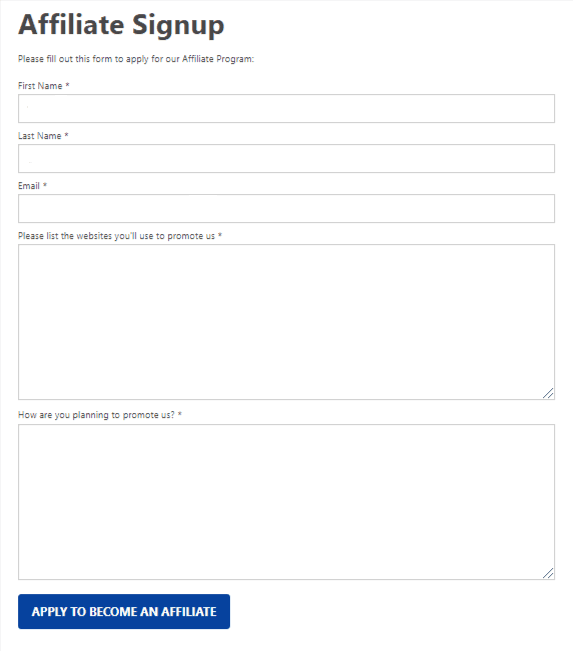Table of Contents
“More than 80% of businesses worldwide have an affiliate program.” – OptinMonster
Affiliate marketing offers a unique opportunity to tap into the networks of skilled marketers who can expand your brand's reach and connect with new audiences.
This strategy is perfect for brands eager to extend their market reach and entrepreneurs looking to turn their online presence into profit.
Launching a successful affiliate program begins with crafting an engaging signup page and an efficient registration form. In this guide, we'll outline the essential components of each, ensuring you draw in a crowd of motivated marketers.
We'll also highlight how Easy Affiliate's built-in tools can make the process smoother, helping you set up and manage your affiliate program with ease.
How to Get More Affiliates to Join Your Program
Simply creating an affiliate program isn't enough to guarantee its success. You're not the only one seeking to onboard affiliates in your industry.
You need to find ways to draw in more affiliates than your competitors.
Start by simplifying your onboarding process, making it as easy as possible for potential affiliates to sign up.
The first thing you need is a dedicated landing page. This is the central spot where potential affiliates can learn about your brand and get all the crucial details of your affiliate program.
Next, you'll need an affiliate registration form. This form is essential for gathering all the information you need from affiliates who are interested in joining your program, ensuring they know exactly what to expect.
Let's dive into what makes a compelling signup page and registration form to effectively attract potential affiliates.
1. Design a Dedicated Affiliate Landing Page
An affiliate landing page is your primary touchpoint with potential affiliates. It’s vital that this page thoroughly presents all the necessary details about your programs and introduces your brand effectively.
Make sure the page is visually appealing and offers clear, straightforward instructions to guide potential affiliates.
Here are some key factors to consider when designing your affiliate landing page:
Value Proposition
When setting up an affiliate program, consider the primary reasons why individuals would be motivated to promote your solutions. The marketplace is crowded with numerous affiliate programs from competing brands.
Your success depends significantly on how well you can communicate the unique advantages of your program.
Affiliate marketers typically have 2 major motivations:
- Their genuine interest in the products you offer.
- The financial rewards they can earn through promotion.
Moreover, affiliates often seek to align with respected and well-known brands. By emphasizing the prestige and benefits of partnering with your company, you can attract more attention and stand out from other affiliate programs.
Commission Structure
A clear and well-explained commission structure can also help attract more affiliates to your program. Make sure all the details about how commissions are structured are straightforward and easy to find, ideally right at the top of your landing page to capture attention quickly.
Start by specifying whether you offer a fixed rate or a percentage of sales as the commission. Clearly outline your payout schedule to avoid any potential confusion or disputes.
The more detailed you are about your commission structure, the better. This transparency helps prevent any misunderstandings.
Here’s a snapshot of the RafflePress affiliate program page that serves as an excellent example for setting up your structure:
Program Details
Not all visitors to your affiliate page will be familiar with how affiliate programs work. Some might be aspiring entrepreneurs just starting their journey in affiliate marketing.
It's important to provide clear information and easy access to essential details. Explain everything they need to know about your program and its operations in a straightforward manner.
Including a comprehensive FAQ section can address common questions and enhance engagement. For example, the AIOSEO Affiliate Program FAQ effectively covers key points and concerns:
Terms and Conditions
Adding terms and conditions to the affiliate signup page helps foster transparency and eliminates the possibility of misunderstandings.
These guidelines outline the specifics of your affiliate program and serve as a reference for potential affiliates. For example, WPForms effectively presents their terms, setting clear expectations from the start:
In your terms, explicitly state all requirements and restrictions, such as permissible marketing activities and affiliate obligations.
For instance, if you prefer that affiliates do not use pay-per-click campaigns to promote your products, this should be clearly mentioned.
This clarity ensures all parties understand the rules before committing to your program.
Contact Details
Most businesses have a contact page for customers; therefore, you should include specific contact details on your affiliate signup page as well.
Affiliates should be able to reach out to you directly, or to the person you've appointed for affiliate support. This direct access is especially valuable for new affiliates who might need some guidance as they start their journey in affiliate marketing.
Making it easier for affiliates to reach out to the relevant personnel not only wins their hearts but also strengthens your relationship with them, paving the way for a more productive partnership.
Clear Call to Action
After providing potential affiliates with all the necessary information and guidance, the next step is to direct them precisely on what to do next.
The call to action serves this purpose by signaling the expected action from potential affiliates.
For example, the Easy Affiliates affiliate program page features an action button that, when clicked, routes visitors directly to the affiliate registration form:


This ensures a smooth transition for visitors ready to join your program, facilitating a seamless signup process.
2. Create an Affiliate Registration Form
Affiliates represent your brand, so it's important to be selective about who can join your program.
This is why a well-crafted affiliate registration form is important. It allows you to gather necessary information from interested candidates, helping you identify those who best fit your brand's vision and values.
The right affiliates can boost your brand, while the wrong ones might hurt its reputation. A good registration form gives you insights into potential affiliates and helps weed out those who aren't a good fit.
However, the design of these forms also needs careful consideration. If they're too long or ask for too much information upfront, you might lose potential affiliates who get frustrated and give up.
To keep prospective affiliates interested, make sure your form is clear and only asks for the essentials:
Start by Getting Their Name
One of the first steps in vetting potential affiliates is conducting a basic background check, which requires their full name.
Use their name to search Google results and review their social media profiles. This can provide insights into their past activities and affiliations, helping you avoid any potential controversies that could harm your brand.
Having their full name also ensures effective communication and allows you to send personalized messages. This fosters engagement and helps build lasting relationships with your affiliates.
Collect Their Contact Information
The second thing you should ask from your affiliates is their contact information. You need to stay connected with your affiliates from the point you onboard them to the point they discontinue being a part of your affiliate program.
Contact information is invaluable for keeping affiliates informed about new deals, updates, or changes within the program. Effective communication fosters a productive partnership, helping your affiliates drive more sales.
While collecting contact details, be mindful that some affiliates might be hesitant to share personal information, such as phone numbers. In such cases, obtaining their email address can suffice for regular communications.
Learn More about Their Business and Promotion Methods
Around 67% of affiliates use social media platforms like Instagram, Facebook, and Twitter to promote the brands they represent. Many also use their websites, leveraging SEO to attract a relevant audience.
Given this diversity in promotional strategies, it's important to request business-related details from potential affiliates. Here are some specific questions you should ask potential affiliates:
- Business Name and Niche: What is the name of your business? What is your area of expertise?
- Primary Promotion Platforms: Which social media platforms do you primarily use for promotion (e.g., Instagram, Facebook, Twitter, YouTube)?
- Website Information: Do you have a website or blog where you promote products and services? If so, what is the URL?
- SEO and Content Strategies: How do you leverage SEO to attract your audience? What types of content do you typically create (e.g., blog posts, videos, social media posts)?
- Audience Demographics: Can you provide details about your target audience (e.g., age, gender, interests)?
- Engagement Metrics: What are your typical engagement metrics on your platforms (e.g., follower count, average likes/comments, website traffic)?
- Previous Brand Collaborations: Have you worked with other brands before? If so, which ones and what were the results?
These details are essential for determining whether there is a match between your brand values and those of the business interested in your affiliate program.
Check Marketing Content Quality
Around 60% of marketers believe that content marketing helps them generate demand and capture quality leads. Effective content can significantly boost your brand's visibility and engage your target audience.
Before onboarding your affiliates, it's important to assess the content they create and share with their audiences. Request examples of their content marketing efforts by asking for links to their blog, website, or social media platforms.
Partnering with affiliates who share irrelevant or low-quality content can be detrimental to your brand. It can tarnish your brand’s image and lead to poor conversion rates by attracting unqualified traffic.
Ensuring that your affiliates produce high-quality, relevant content helps maintain your brand’s reputation and drives better results.
Get Started with Easy Affiliate’s Seamless Signup Features
Now that you understand the key elements of an effective affiliate registration form, it’s time to put that knowledge into action.
While there are numerous form builder integrations available, such as Formidable Forms and WPForms, Easy Affiliate simplifies the entire process with its built-in capabilities.
Easy Affiliate comes equipped with an intuitive affiliate signup page that is part of its core features, eliminating the need for external tools.
To set this up, simply navigate to Easy Affiliate > Settings, and under the General tab, you'll find the Affiliate Pages section.
Here, the Affiliate Signup Page is one of three pre-configured pages ready for your use:

This signup page is expertly designed to capture all necessary information from potential affiliates, including fields for the affiliate's name, email, website(s), intended promotional methods, and social media handles.

Additionally, within the Affiliates tab in the same Settings menu, Easy Affiliate offers flexibility in how you manage incoming applications.
You can choose to automatically accept new affiliates, allowing them to start promoting your products immediately, or opt to manually review each application.
This manual review process ensures that you can assess potential affiliates to confirm they align with your brand values and marketing goals before granting them entry into your program.
>> See our Support Doc on How to Manage Affiliate Applications
By using Easy Affiliate’s built-in form and management options, you streamline the signup and review processes, making it effortless for you and attractive for potential affiliates, thereby increasing the chances of attracting top-tier partners to promote your brand.
Final Words
Affiliate marketing stands out as a powerful strategy for brands looking to expand their reach and engage with a targeted audience through third-party platforms.
However, the challenge often lies in attracting dependable affiliates, as you are not the only brand in your industry offering an affiliate program.
The secret to gaining a competitive edge and drawing in more affiliates lies in crafting a smooth and user-friendly onboarding process. Many brands falter here, with overly complex signup pages and cumbersome registration forms deterring potential affiliates.
To capitalize on the potential of affiliate marketing, we strongly advise simplifying the affiliate onboarding process. Focus on the essential elements: create a clear, concise signup page and streamline the registration form.
By making it easier for affiliates to join your program, you'll not only enhance your attractiveness as a partner but also increase your chances of forming lucrative and lasting partnerships.
Do you prefer manual or automatic approval for affiliate applications? Share your preference and why in the comments!
If you liked this article, follow us on Twitter, Facebook, Pinterest, and LinkedIn. And don't forget to subscribe to our newsletter!



Hi! TikTok pwedi ba akong maging affiliate kahit di umabot sa 600 Ang followers ko?